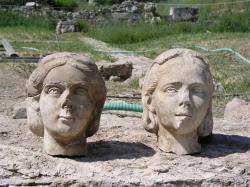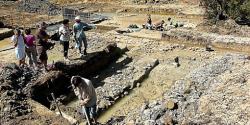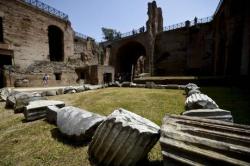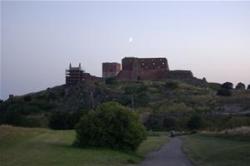INSTITUT SUPERIEUR D'ANTHROPOLOGIE
INSTITUTE OF ANTHROPOLOGY
ONLINE COURSES / COURS A DISTANCE
FALL TERM : OCTOBER 2013
REGISTER NOW
EGYPTE –  Tell el-Murra - Remains of a settlement from the period of the great pyramid builders (Dynasty III-VI) have been uncovered at Tell el-Murra in the Nile Delta by Polish archaeologists from the Institute of Archaeology of the Jagiellonian University. The team has been working at Tell el-Murra since 2008. The settlement is located in the north-eastern part of the Nile Delta, in the vicinity of another site from the same period,Tell el-Farkha, studied also by Polish archaeologists. Tell el-Murra is a small hill, covering the remains of an ancient settlement, founded more than 5500 years ago. Here, the construction of buildings made of dried bricks on the same site went on for 1,300 years, forming an elevation (tell), which now reaches a few meters above the level of fields. Excavations at Tell el-Murra in April and May 2013 were conducted mainly in the north-eastern part of the site, occupied by the settlement. The objective was to confirm the hypothesis based on earlier work, relating to the period in which the settlement had been inhabited.
Tell el-Murra - Remains of a settlement from the period of the great pyramid builders (Dynasty III-VI) have been uncovered at Tell el-Murra in the Nile Delta by Polish archaeologists from the Institute of Archaeology of the Jagiellonian University. The team has been working at Tell el-Murra since 2008. The settlement is located in the north-eastern part of the Nile Delta, in the vicinity of another site from the same period,Tell el-Farkha, studied also by Polish archaeologists. Tell el-Murra is a small hill, covering the remains of an ancient settlement, founded more than 5500 years ago. Here, the construction of buildings made of dried bricks on the same site went on for 1,300 years, forming an elevation (tell), which now reaches a few meters above the level of fields. Excavations at Tell el-Murra in April and May 2013 were conducted mainly in the north-eastern part of the site, occupied by the settlement. The objective was to confirm the hypothesis based on earlier work, relating to the period in which the settlement had been inhabited.
http://www.archaiologia.gr/
FRANCE – Toulouse - Un chantier de fouilles préventives menées par le service archéologique de Toulouse Métropole, débute aujourd’hui, sur le tracé du Boulevard urbain nord (BUN) . «Nous allons commencer par le secteur de Launaguet car nous pouvons y suspecter des vestiges datant du néolithique (-4 000 avant notre ère), précise Pierre Pisani, archéologue et chef du service. Nous savons que des fermes de l’époque néolithique étaient installées sur ce secteur, car nous avons pu identifier des fossés de défense, typiques de cette époque.» Le service archéologique va procéder toute la semaine à des fouilles, en creusant des tranchées à la pelle mécanique, espacées de 10 mètres sur une profondeur d’un à deux mètres, ce qui correspond au niveau du sol géologique. «Nous allons explorer 10 % de chacune des parcelles concernées, sur un territoire d’un hectare et demi. Il se peut également que nous trouvions des vestiges datant de l’époque médiévale, ou gallo-romaine. Nous connaissons peu cette partie de l’histoire sur le territoire toulousain…».
http://www.ladepeche.fr/article/2013/07/16/1672262-des-fouilles-archeologiques-preventives-sur-le-trace-du-bun.html
GRECE –  Athènes - Two marble female heads, dating from the 3rd Century AD, were discovered during the works of the German Archaeological Institute at Kerameikos. The findings were revealed during the cleaning of a well, which belongs to a bath of the Classical era and is near the Dipylon Gate. Having received the permission to clean the well by the Archaeological service, the head of the institute for excavations, Utah Strotsek, used four pumps to remove the water. The two bust came across during the procedure. The finds are in a very good condition. Still, two massive strikes on their surface indicate that someone hit them hard in order to break them and then threw them into the well. According to Utah Strotsek, the busts were dated based on the style of the headdress. Their hair is reminiscent of Salonina, wife of the Emperor Gallienus and mother of Valerianus, who is depicted on the coins of the era. The well itself was an impressive construction, stone built and is coated with hydraulic lime-mortar of excellent quality. It was believed to have been in use for 800 years during the 5th-6th century AD). The German Archaeological Institute, which celebrates its 100 years of excavations in Kerameikos this year, has started a new program of restoration and conservation of the monuments of Kerameikos. Except for the bath and its well, the works involve the Sacred Gate, funerary monuments and a temple of goddess Artemis and the restoration of the unique little temple of Agathon, which is held in cooperation with the Archaeological Service.
Athènes - Two marble female heads, dating from the 3rd Century AD, were discovered during the works of the German Archaeological Institute at Kerameikos. The findings were revealed during the cleaning of a well, which belongs to a bath of the Classical era and is near the Dipylon Gate. Having received the permission to clean the well by the Archaeological service, the head of the institute for excavations, Utah Strotsek, used four pumps to remove the water. The two bust came across during the procedure. The finds are in a very good condition. Still, two massive strikes on their surface indicate that someone hit them hard in order to break them and then threw them into the well. According to Utah Strotsek, the busts were dated based on the style of the headdress. Their hair is reminiscent of Salonina, wife of the Emperor Gallienus and mother of Valerianus, who is depicted on the coins of the era. The well itself was an impressive construction, stone built and is coated with hydraulic lime-mortar of excellent quality. It was believed to have been in use for 800 years during the 5th-6th century AD). The German Archaeological Institute, which celebrates its 100 years of excavations in Kerameikos this year, has started a new program of restoration and conservation of the monuments of Kerameikos. Except for the bath and its well, the works involve the Sacred Gate, funerary monuments and a temple of goddess Artemis and the restoration of the unique little temple of Agathon, which is held in cooperation with the Archaeological Service.
http://www.archaiologia.gr/en/blog/2013/07/22/marble-female-heads-found-in-kerameikos-well/
FRANCE –  Loudun - Obligatoires avant toute construction, des fouilles préventives ont été lancées sur la future zone commerciale Caréo. Elles dureront jusqu’au 4 août. Mais la zone ne devient pas pour autant un grand champ de fouilles. « Sur les 16 hectares du projet, 5 à 10 % sont étudiés. Je procède par tranchées parallèles tous les 18 m. Le sondage est réalisé à l'aide d'une pelle mécanique qui enlève les différentes couches et on s'arrête au calcaire, explique Marie-Claude Bakkal-Lagarde, archéologue à l'Inrap. On peut trouver des murs, des fossés. Ici, nous avons trouvé des drains qui servaient à apporter l'eau ».
Loudun - Obligatoires avant toute construction, des fouilles préventives ont été lancées sur la future zone commerciale Caréo. Elles dureront jusqu’au 4 août. Mais la zone ne devient pas pour autant un grand champ de fouilles. « Sur les 16 hectares du projet, 5 à 10 % sont étudiés. Je procède par tranchées parallèles tous les 18 m. Le sondage est réalisé à l'aide d'une pelle mécanique qui enlève les différentes couches et on s'arrête au calcaire, explique Marie-Claude Bakkal-Lagarde, archéologue à l'Inrap. On peut trouver des murs, des fossés. Ici, nous avons trouvé des drains qui servaient à apporter l'eau ».
http://www.lanouvellerepublique.fr/Toute-zone/Actualite/Environnement/n/Contenus/Articles/2013/07/24/Que-recele-le-sous-sol-de-la-zone-commerciale-1558020
FRANCE –  Narbonne - De nouvelles recherches au port antique. Le site portuaire antique de Narbonne, considéré comme l’un des plus importants du monde romain, fait l’objet de recherches intensives depuis 2010 dans le cadre d’un partenariat de quatre ans signé entre la Région et le CNRS, principaux financeurs, le ministère de la Culture, l’Université Montpellier III, l’Inrap et le Conservatoire du Littoral, propriétaire du site du Castélou. Unique en France, le chantier de fouilles, qui ont livré des résultats exceptionnels, concerne plusieurs secteurs : l’île Saint-Martin à Gruissan, où était installée une “préfecture maritime” à l’entrée des étangs de Bages et Sigean ; le lac de Capelles à Port-la-Nautique, où ont été mis en évidence de grands entrepôts pour le stockage du vin ; le Castélou/Mandirac, où ont été retrouvés des aménagements portuaires dans la lagune avec jetées et appontements et où les fouilles ont révélé l’existence d’un canal de 50 m de large et 5 m de profondeur qui pouvait accueillir des bateaux de toute la Méditerranée.
Narbonne - De nouvelles recherches au port antique. Le site portuaire antique de Narbonne, considéré comme l’un des plus importants du monde romain, fait l’objet de recherches intensives depuis 2010 dans le cadre d’un partenariat de quatre ans signé entre la Région et le CNRS, principaux financeurs, le ministère de la Culture, l’Université Montpellier III, l’Inrap et le Conservatoire du Littoral, propriétaire du site du Castélou. Unique en France, le chantier de fouilles, qui ont livré des résultats exceptionnels, concerne plusieurs secteurs : l’île Saint-Martin à Gruissan, où était installée une “préfecture maritime” à l’entrée des étangs de Bages et Sigean ; le lac de Capelles à Port-la-Nautique, où ont été mis en évidence de grands entrepôts pour le stockage du vin ; le Castélou/Mandirac, où ont été retrouvés des aménagements portuaires dans la lagune avec jetées et appontements et où les fouilles ont révélé l’existence d’un canal de 50 m de large et 5 m de profondeur qui pouvait accueillir des bateaux de toute la Méditerranée.
http://www.midilibre.fr/2013/07/23/ports-antiques-de-nouvelles-recherches,737722.php
ITALIE –  Rome - Medieval remains in the Imperial Forum that include a workshop are most likely from the 8th century AD, archaeologists from Rome's Roma Tre university said on Tuesday. "The remains found in the Temple of Peace (Tempio della Pace) area are probably related to blacksmith activity," professor Riccardo Santangeli Valenzani said. Another area from the Middle Ages, dating back to approximately the 14th century AD, was most likely a housing complex or residential area, Valenzani said. The university project in collaboration with Rome's archeological superintendency was "dedicated to understanding the transformations of monuments after the fall of the Roman Empire, from the sixth century to the Middle Ages," Valenzani said.
Rome - Medieval remains in the Imperial Forum that include a workshop are most likely from the 8th century AD, archaeologists from Rome's Roma Tre university said on Tuesday. "The remains found in the Temple of Peace (Tempio della Pace) area are probably related to blacksmith activity," professor Riccardo Santangeli Valenzani said. Another area from the Middle Ages, dating back to approximately the 14th century AD, was most likely a housing complex or residential area, Valenzani said. The university project in collaboration with Rome's archeological superintendency was "dedicated to understanding the transformations of monuments after the fall of the Roman Empire, from the sixth century to the Middle Ages," Valenzani said.
http://www.ansa.it/web/notizie/rubriche/english/2013/07/23/Medieval-area-Roman-Imperial-Forum-uncovered_9063920.html
DANEMARK –  Bornholm - The second season begins of excavations of Polish archaeologists from the Institute of Archaeology, University of Warsaw on Bornholm. This time, the focus will be on the thirteenth-century castle Hammershus. According to Janowski, the construction of the castle began in 1250 on the order of the archbishop of Lund. Since ancient times, the island and the castle passed from the Swedish to Danish hands and vice versa several times. In 1743 the castle was demolished and part of the building material used to build the fortress on Christianso. During the Thirty Years' War, Corfitz Ulfeldt and his wife Leonora Christina, half-sister of King Frederick III, were imprisoned in Hammershus. His betrayal and the service to King Charles X of Sweden contributed to Denmark losing the Danish-Swedish war (1643-1645) and signing an unfavourable peace accord in Bromsebro. Stronger Sweden had an open path to the Deluge in 1655.
Bornholm - The second season begins of excavations of Polish archaeologists from the Institute of Archaeology, University of Warsaw on Bornholm. This time, the focus will be on the thirteenth-century castle Hammershus. According to Janowski, the construction of the castle began in 1250 on the order of the archbishop of Lund. Since ancient times, the island and the castle passed from the Swedish to Danish hands and vice versa several times. In 1743 the castle was demolished and part of the building material used to build the fortress on Christianso. During the Thirty Years' War, Corfitz Ulfeldt and his wife Leonora Christina, half-sister of King Frederick III, were imprisoned in Hammershus. His betrayal and the service to King Charles X of Sweden contributed to Denmark losing the Danish-Swedish war (1643-1645) and signing an unfavourable peace accord in Bromsebro. Stronger Sweden had an open path to the Deluge in 1655.
http://www.naukawpolsce.pap.pl/en/news/news,396349,polish-archaeologists-return-to-bornholm.html
BELGIQUE –  Tournai – La tour de la rue du Marché au Jambon n’est pas l’unique découverte archéologique réalisée cet été à Tournai. Début de semaine, des travaux de terrassement réalisés au sein de l’église Sainte-Marguerite ont permis de mettre au jour les murs d’une ancienne église ainsi que sa crypte. «Il s’agit d’une église paroissiale datant de 1363, explique Isabelle Deramaix, archéologue au SPW. L’abbatiale que l’on connaît actuellement date quant à elle de 1756.» S’il ne s’agit pas du plus ancien édifice construit à cet endroit – une chapelle y avait été érigée en 1288-, la découverte n’en est pas moins belle.
Tournai – La tour de la rue du Marché au Jambon n’est pas l’unique découverte archéologique réalisée cet été à Tournai. Début de semaine, des travaux de terrassement réalisés au sein de l’église Sainte-Marguerite ont permis de mettre au jour les murs d’une ancienne église ainsi que sa crypte. «Il s’agit d’une église paroissiale datant de 1363, explique Isabelle Deramaix, archéologue au SPW. L’abbatiale que l’on connaît actuellement date quant à elle de 1756.» S’il ne s’agit pas du plus ancien édifice construit à cet endroit – une chapelle y avait été érigée en 1288-, la découverte n’en est pas moins belle.
http://www.lavenir.net/article/detail.aspx?articleid=dmf20130725_00339667